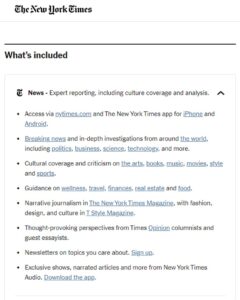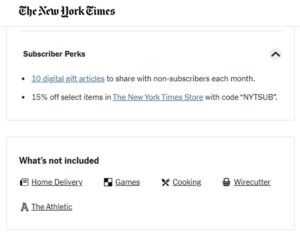Product bundling is top of mind for many publishers as they seek to grow digital subscription revenue with additional products. Combining products into bundles and pricing those bundles are important strategic decisions. Other industries have practiced bundling effectively for decades, but it is a relatively new practice for the news industry. In this post the strategy and economics of bundling are summarized to help publishers explore a product bundling strategy.
Why should you bundle products?
- To create market differentiation and reduce direct price comparison.
- To create competitive advantage by bundling products and services that are directly suited for a customer segment’s buyer values and user needs.
- To increase the average purchase amount. Customers will often purchase more of your products in a bundle than they would separately.
- To reduce churn among subscribers by growing customer engagement, adding perceived value, and offering retention incentives of upgraded product access
Bundles in Publishing and other industries
Consumers receive value from products they purchase. The difference between the value they receive and the price they pay is called consumer surplus. Traditional printed newspapers are a bundle of different content topics, and each of them could be considered a product: local news, sports, business, culture, entertainment, and classifieds. Consumers place different values on each content section, and they agree to purchase the bundle when the aggregate perceived value exceeds the price of the subscription. If they could only buy the sections that they valued most, they would often prefer to do that.
In economics terms, the products in the bundle that create consumer surplus lead customers to purchase a bundle that includes the products they value most along with other products that may offer little value to them. Thus, they are buying more in a bundle than they would if purchasing your products separately.
News organizations are creating content bundles in digital form that resemble the bundles they have offered in print. They are adding e-commerce services, in-depth coverage of certain content categories, games, and multi-media offerings with audio and video content. These bundles will lead to incremental subscription sales as the perceived value of bundled offerings exceed the cost of the bundles for more of the target audience.
The music industry was forced to unbundle their products, albums, when streaming services enabled listeners to purchase single songs, and their revenue declined significantly until they adjusted their business models, in many cases by offering subscriptions to music services to replace music sales.
Cable television has included sports networks, such as ESPN, in bundles with many other channels that customers often do not value, because they know many customers will pay for the premium bundle to get access to the sports content.
The New York Times has expanded its product bundles. An example of the basic digital bundle is below. Recently, New York Times Audio was added to the basic bundle around the same time as a digital price increase but with no incremental cost specifically for that service. Wirecutter and The Athletic were not included in the basic bundle but made part of the All-Access Bundle option. These two products are comparable to HBO (a premium movie channel in cable product bundles), where there are smaller target customer segments with high willingness to pay.
Example of how New York Times bundles product offering


What are the steps to developing product bundles?
At a high level, these are the steps to creating and pricing successful product bundles:
- Define buyer values and user needs for your customer segments. Examples are Sports enthusiasts, News consumers, Community minded, Financial contributors, and Deal seekers.
- Define the value proposition for each product. Curated and trusted news is one example. Unparalleled access to sports team players and management is another.
- Quantify the size of the market opportunity for products for target customer segments. Is it a large market vs smaller target segment? Is there a high willingness to pay for this product from the segment?
- Form hypotheses about which products are “must haves” for customer segments vs “nice to haves”.Identify products that differentiate the appeal of a product bundle to one customer segment versus another.
- Compare substitute products in the market and understand the consumption of those substitutes by your target customer segments. How differentiated is our product in comparison to alternatives?
- Define the strategic positioning of your products relative to competitors and substitutes. Are we a premium product in the market, a second subscription, or are we seeking penetration of our primary market.
- Identify prices for direct competitors and substitute products in the market. What acquisition offer terms and full prices are in the market for comparable products. These will be the reference prices for your target market when they decide to buy your products.
- Position bundles and prices to leverage known customer behavior, such as having an anchor price point, tiered bundles, and promoting cost savings from bundles. These pricing tactics should be consistent with your desired brand positioning.
- Design and test alternative product bundles and price points in the market. Continue to iterate with product development, market research, and market testing.
Product bundles are a powerful tactic for publishers that significantly increase revenue through volume growth, improved retention, and higher average prices. Bundles increase the value proposition of your products to your customers and offer strategic pricing opportunities across customer segments.
An even more compelling aspect of a product bundling strategy is the information you receive from observing customer buying decisions, particularly from anonymous digital readers. By selecting a bundle, a reader is giving you a strong signal about their perceived value of your products and what elements of your offering are important to them. In effect, they are “self-selecting” themselves into a customer segment.

